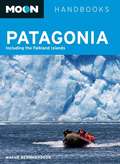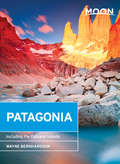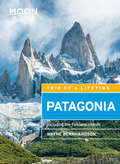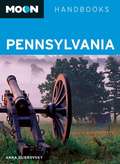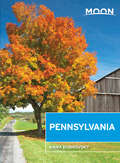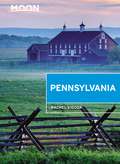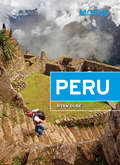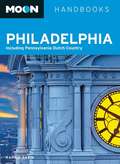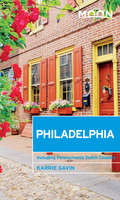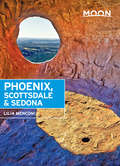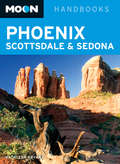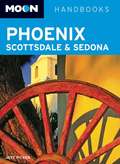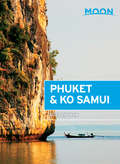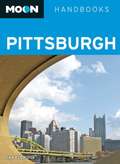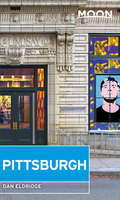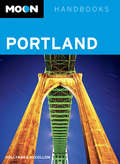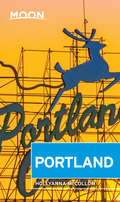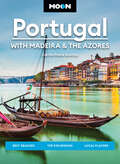- Table View
- List View
Moon Patagonia
by Wayne BernhardsonVeteran travel writer Wayne Bernhardson covers the best sights and adventures that Patagonia has to offer, from viewing the jagged peaks of Cuernos del Paine and hiking on Argentina's Moreno Glacier to visiting Ushuaia, the world's southernmost city. Bernhardson also offers various trip strategies, including The Andean Lakes Loop and The Natural History Tour. Including details on exploring the penguin-dotted Falkland Islands, staying in guest ranches in the Patagonian outback, and whale watching at the World Heritage Site of Península Valdés,Moon Patagoniagives travelers the tools they need to create a more personal and memorable experience.
Moon Patagonia
by Wayne BernhardsonTravel writer Wayne Bernhardson covers the best sights and adventures that Patagonia has to offer, from viewing the jagged peaks of Cuernos del Paine and hiking on Argentina's Moreno Glacier to visiting Ushuaia, the world's southernmost city. Bernhardson also offers various trip strategies, including The Andean Lakes Loop and The Natural History Tour. Including details on exploring the penguin-dotted Falkland Islands, staying in guest ranches in the Patagonian outback, and whale watching at the World Heritage Site of Península Valdés, Moon Patagonia gives travelers the tools they need to create a more personal and memorable experience.
Moon Patagonia: Fjords, Glaciers, Road Trips (Moon Latin America & Caribbean Travel Guide)
by Wayne Bernhardson Moon Travel GuidesPatagonia's staggering landscapes, titanic glaciers, and rugged mountains evoke mystery and inspire self-discovery. Go to the ends of the earth with Moon Patagonia. Inside you&’ll find:Flexible itineraries including ten days exploring the best of the region, classic Patagonia road trips, and more Outdoor adventures: Hike the glacier of Perito Moreno National Park, see penguins and marine mammals off the coast of the Falkland Islands, and go horseback riding through the Torres mountains The top sights and unique experiences: Glimpse Patagonia's ancient past at Cueva de las Manos or visit Chile's lakes district to learn more about the Mapuche people. Savor authentic asado at a local ranch, sample seafood in Santiago, and take a tango lesson in Buenos Aires Expert author and world traveler Wayne Bernhardson shares his perspective on his favorite place on earth Full-color, vibrant photos throughoutDetailed maps and useful tips for getting around and exploring on your own Focused coverage of Buenos Aires, Santiago de Chile, Northern Argentine Patagonia, the Chilean Lakes District, Aisén and Continental Chiloé, Southern Argentine Patagonia, Magallanes, Argentine Tierra del Fuego, and the Falkland Islands Thorough background information on the landscape, culture, history, and environment With Moon Patagonia's practical tips and insider advice, you can have the trip of a lifetime. Want to see more of South America? Check out Moon Chile or Moon Ecuador and the Galápagos Islands.About Moon Travel Guides: Moon was founded in 1973 to empower independent, active, and conscious travel. We prioritize local businesses, outdoor recreation, and traveling strategically and sustainably. Moon Travel Guides are written by local, expert authors with great stories to tell—and they can&’t wait to share their favorite places with you. For more inspiration, follow @moonguides on social media.
Moon Patagonia: Including The Falkland Islands (Travel Guide)
by Wayne BernhardsonYour World Your Way! Patagonia's staggering landscapes, titanic glaciers, and rugged mountains evoke mystery and inspire self-discovery. Explore the ends of the earth with Moon Patagonia.What You'll Find in Moon Patagonia:Expert author and world traveler Wayne Bernhardson shares his perspective on his favorite place on earthFull-color guidebook with vibrant, helpful photosDetailed directions and maps for getting around and exploring on your ownStrategic itineraries, including The Best of Patagonia, Wildlife Encounters, Explore the Natural World, Glacier Gazing, and Classic Patagonia Road TripsActivities and ideas for every traveler: Hike the glacier of Perito Moreno National Park, or glimpse Patagonia's pre-Colombian past at Cueva de las Manos. See penguins and marine mammals off the coast of the Falkland Islands, or visit Chile's lakes district, home to the Mapuche people. Savor authentic asado at a local ranch, and go horseback riding through the Torres mountains. Sample seafood in Santiago, or take in tango in Buenos AiresIn-depth coverage for Buenos Aires, Santiago de Chile, Northern Argentine Patagonia, The Chilean Lakes District, Aisén and Continental Chiloé, Southern Argentine Patagonia, Magallanes, Argentine Tierra del Fuego, and the Falkland IslandsAccurate information, including background on the landscape, culture, history, and environmentHandy tools such as travel tips and safety information in an easy-to-navigate format, all packaged in a book light enough to fit in your daypackWith Moon Patagonia's practical tips, myriad activities, and an insider's view on the best things to do and see, you can plan your trip your way.
Moon Pennsylvania: 2011
by Anna DubrovskyPennsylvania resident and voracious traveler Anna Dubrovsky covers the best of the Keystone State, including Philadelphia, Amish country, the Pocono Mountains, Hershey, and Presque Isle. She offers a variety of unique travel strategies-from kid-pleasing getaways to rail fan meccas-and details the most popular sights, including the Liberty Bell, Independence Hall, Gettysburg National Military Park, and Fallingwater. Complete with expert tips on places to dine, sleep, and shop, Moon Pennsylvania gives travelers the tools they need to create a more personal and memorable experience.
Moon Pennsylvania: 2014
by Anna DubrovskyPennsylvania resident and voracious traveler Anna Dubrovsky covers the best of the Keystone State, including Philadelphia, Amish country, the Pocono Mountains, Hershey, and Presque Isle. She offers a variety of unique travel strategies-from kid-pleasing getaways to rail fan meccas-and details the most popular sights, including the Liberty Bell, Independence Hall, Gettysburg National Military Park, and Fallingwater. Complete with expert tips on places to dine, sleep, and shop, Moon Pennsylvania gives travelers the tools they need to create a more personal and memorable experience.
Moon Pennsylvania: Including Pittsburgh, The Poconos, Philadelphia, Gettysburg, And The Dutch Country (Travel Guide)
by Rachel VigodaVisit historic battlefields, share the road with horse-drawn buggies, and explore two vibrant cities on the rise. Inside Moon Pennsylvania you'll find:Strategic itineraries like a 7-day spin through the best of the state, weekend trips, and tips for history buffs, families, and outdoor adventurersThe top sights and unique experiences: Sneak a peek at the Liberty Bell and museum-hop in Philadelphia and Pittsburgh. Hike, camp, or show off your snowboarding skills in the Poconos, spot roaming elk in the Pennsylvania Wilds, and relax on the shores of Lake Erie. Learn about American history at Gettysburg, marvel at Frank Lloyd Wright's masterpiece in the Laurel Highlands, or take a horse-drawn buggy through Amish country. Find the best Philly cheesesteak, indulge in all that Hershey has to offer, and try a "Pittsburgh-style" sandwich stuffed with friesSuggestions for day trips from Philadelphia and Pittsburgh, including Bucks County, Amish Country, Moraine and McConnells Mill State Parks, Fallingwater, and Cook Forest State ParkLocal tips from Philadelphia local Rachel Vigoda on when to go, how to get around, and where to stayThorough background information on the landscape, wildlife, climate, and local culture Focused coverage of Philadelphia, Pennsylvania Dutch Country, the Pocono Mountains, Pittsburgh, the Alleghenies, the Lake Region, and Pennsylvania WildsWith Moon Pennsylvania's practical tips and local insight, you can experience the best of the Keystone State.Staying in the city? Try Moon Pittsburgh or Moon Philadelphia. Exploring more of the East Coast? Try Moon Virginia & Maryland or Moon Washington DC.
Moon Peru (Travel Guide)
by Ryan DubéYour World Your Way! Once the ancient empire of the Inca, Peru still draws visitors with its blend of mystery, lively culture, and beautiful rugged landscape. Explore with Moon Peru.What You'll Find in Moon Peru:Expert, local author Ryan Dubé shares his perspective on his home country Full-color guidebook with vibrant, helpful photosDetailed directions and maps for exploring on your ownStrategic itineraries, such as The Best of Peru, From the Inca to the Amazon, Archaeology Intensive, and 48 Hours in LimaIn-depth coverage for Lima, The Sacred Valley, Machu Picchu, Cusco, Lake Titicaca and Canyon Country, The Amazon, Nasca and the Desert Coast, The Central Highlands, Huaraz and the Cordillera Blanca, Trujillo and the North Coast, and Cajamarca and the Northern HighlandsActivities and ideas for every traveler: Wander the cobblestone streets of Cusco, marveling at the Spanish churches built atop massive Inca walls. Try alpaca steaks and sweet corn, or heaping bowls of ceviche. Explore the mystery of the Nazca Lines, or float down the Amazon. Trek (or train) into the cloud forests of the Peruvian mountains to see one of the world's great wonders: the stone city of Machu PicchuAccurate information, including background on the landscape, history, and cultureHandy tools such as travel tip and safety information in an easy to navigate format, all packaged in a book light enough to fit in your daypackWith Moon Peru's practical tips, myriad activities, and an insider's view on the best things to do and see, you can plan your trip your way.
Moon Peru: 2011
by Ross Wehner Renee Del GaudioFormer Peru residents Ross Wehner and Renée Del Gaudio offer an insider's view of Peru, from exploring the churches and artisan neighborhoods of Cusco to avoiding the crowds at Machu Picchu and picnicking on the wilderness beach of Reserva Nacional Paracas. The husband-and-wife team also include unique trip ideas like Getting off the Gringo Trail, Archaeological Treasures, and 10 Days in Peru. Moon Peruis complete with details on trekking the Inca Trail, exploring the Amazon, and surfing in Lima.
Moon Peru: 2014
by Ben Westwood Ryan DubéThis full-color guide to Peru includes vibrant photos and helpful planning maps.Lima resident Ryan Dubé (along with helpful Machu Picchu expert Ben Westwood) offers an insider's view of Peru, from exploring the churches and artisan neighborhoods of Cusco to avoiding the crowds at Machu Picchu and picnicking on the wilderness beach of Reserva Nacional Paracas. Dubé also includes unique trip ideas like Beer, Anyone? and Archaeology Intensive. Complete with details on trekking the Inca Trail, exploring the Amazon, and attending Mistura (Latin America's largest food festival) in Lima, Moon Peru gives travelers the tools they need to create a more personal and memorable experience.
Moon Philadelphia: 2011
by Karrie GavinJournalist and Philadelphia native Karrie Gavin guides travelers around her hometown, from exploring Wissahickon Park to sampling the city's renowned cheesesteaks, soft pretzels, and hoagies. Gavin also includes one-of-a-kind trip ideas such as the Two-Day Best of Philadelphia and Philly's Culinary Classics. With advice on the visiting the Philadelphia Museum of Art, enjoying recreational opportunities on the Schuylkill River, and navigating Philly's nightlife,Moon Philadelphiagives travelers the tools they need to create a more personal and memorable experience.
Moon Philadelphia: 2014
by Karrie GavinJournalist and Philadelphia native Karrie Gavin guides travelers around her hometown in Moon Philadelphia. She knows the best way to experience the City of Brotherly Love, whether it's exploring the 9,200 acres of Fairmount Park or sampling the city's renowned cheesesteaks, soft pretzels, and hoagies. With advice on the navigating Philly's nightlife, wandering the Philadelphia Museum of Art, and enjoying recreational opportunities on the Schuylkill River, Moon Philadelphia gives travelers the tools they need to create a more personal and memorable experience.
Moon Philadelphia: Including Pennsylvania Dutch Country (Travel Guide)
by Karrie GavinSee Philadelphia with a Local Travel writer and native Philadelphian Karrie Gavin shares her expert perspective on the City of Brotherly Love, guiding you on a memorable and unique experience. Whether you're exploring the 9,200 acres of Fairmount Park or sampling the city's renowned cheesesteaks, soft pretzels, and hoagies, Moon Philadelphia has activities for every traveler. With itineraries like "Three-Day Best of Philadelphia” and "Fun and Free: Philly on a Budget,” expertly crafted maps, gorgeous photos, and Karrie's trustworthy advice, Moon Philadelphia provides the tools for planning your perfect trip!Moon Philadelphia covers can't-miss sights and the best destinations including: Washington Square Pennsylvania Dutch Country Brandywine Valley
Moon Phoenix, Scottsdale & Sedona
by Lilia MenconiSee the City with a Local Local writer and avid hiker Lilia Menconi shares her expert perspective on the Valley of the Sun, guiding you on a memorable and unique experience. Whether you're admiring Phoenix's sandstone peaks, the red rocks of Sedona, or relaxing in Scottsdale, Moon Phoenix, Scottsdale & Sedona has activities for every traveler. With itineraries like "Southwestern Culture and Heritage” and "La Buena Vida: Desert Chic,” expertly crafted maps, gorgeous photos, and Lilia's trustworthy advice, Moon Phoenix, Scottsdale & Sedona provides the tools for planning your perfect trip!Moon Phoenix, Scottsdale & Sedona covers can't-miss sights and the best destinations including: Phoenix and vicinity Apache Trail and Superstition Mountains Scottsdale and vicinity Sedona and Red Rock Country Jerome and the Verde Valley
Moon Phoenix, Scottsdale & Sedona: 2013
by Kathleen BryantIn Moon Phoenix, Scottsdale & Sedona, longtime Arizona resident Kathleen Bryant covers the hot spots of the Valley of the Sun, including Phoenix's sandstone peaks, the red rocks and vortexes of Sedona, and the best golf courses and shopping Scottsdale has to offer. Discover the rich culture of the Native American tribes who first settled the Valley, venture north to the leafy respite of Oak Creek Canyon, marvel at larger-than-life cacti at the Desert Botanical Garden, or explore fossils at the Mesa Southwest Museum. Packed with information on the best dining, transportation, and accommodations, Moon Phoenix, Scottsdale & Sedona caters to a range of travel budgets. With unique travel strategies such as Desert Romance and Southwest Heritage, Moon Phoenix, Scottsdale & Sedona gives travelers the tools they need to create a more personal and memorable experience.This ebook and its features are best experienced on iOS or Android devices and the Kindle Fire.
Moon Phoenix, Scottsdale & Sedona: Desert Getaways, Local Flavors, Outdoor Recreation (Travel Guide)
by Lilia MenconiWhether you're hiking red rock trails in the Valley of the Sun or relaxing in Scottsdale's resorts, take Arizona at your own speed with Moon Phoenix, Scottsdale & Sedona. Inside you'll find:Strategic, flexible itineraries like a luxurious desert getaway, a family road trip, and the 4-day best of the Valley of the Sun Unique experiences and can't-miss sights: Explore the local art scene, from Indigenous exhibits to contemporary galleries, and taste the best Sonoran-style cuisine this side of the Mexican border. Luxuriate in five-star resorts, world-class spas, and gourmet restaurants. Go stargazing in Sedona or bar-hopping in Scottsdale. Hike water-carved canyons and climb mountains or hit the links in the golf capital of the West. Discover the rich culture of the Indigenous peoples who first settled the Valley, and venture to the leafy respite of Oak Creek Canyon to picnic between trout-filled ponds and towering red-rock monoliths The top spots for outdoor adventures, from rock climbing and hiking along hidden mountain trails to sunset hot air ballooning and exhilarating desert Jeep tours Expert advice from Phoenix local Lilia Menconi on when to go, how to get around, and where to stay, with special focus on the best resorts in the area Full-color, vibrant photos and detailed maps throughoutThorough background on the culture, environment, wildlife, and history With Moon's practical tips and local know-how, you can experience Phoenix, Scottsdale, and Sedona your way. Expanding your trip? Try Moon Arizona & the Grand Canyon. Hitting the road? Try Moon Southwest Road Trip.About Moon Travel Guides: Moon was founded in 1973 to empower independent, active, and conscious travel. We prioritize local businesses, outdoor recreation, and traveling strategically and sustainably. Moon Travel Guides are written by local, expert authors with great stories to tell—and they can't wait to share their favorite places with you. For more inspiration, follow @moonguides on social media.
Moon Phoenix, Scottsdale and Sedona: 2010
by Jeff FickerLongtime Phoenix journalist and Arizona Monthly co-founder Jeff Ficker has nearly a decade of experience covering Phoenix as a writer and editor. In Moon Phoenix, Scottsdale & Sedona, he covers the hot spots of the Valley of the Sun, including Phoenix's sandstone peaks, the red rocks and vortexes of Sedona, and the best golf courses and shopping Scottsdale has to offer. Discover the rich culture of the Native American tribes who first settled the Valley, venture north to the leafy respite of Oak Creek Canyon, marvel at larger-than-life cacti at the Desert Botanical Garden, or explore fossils at the Mesa Southwest Museum. Packed with information on the best dining, transportation, and accommodations, Moon Phoenix, Scottsdale & Sedona caters to a range of travel budgets. With unique travel strategies such as Desert Romance and Southwest Heritage, Moon Phoenix, Scottsdale & Sedona gives travelers the tools they need to create a more personal and memorable experience.
Moon Phuket & Ko Samui (Moon Handbooks)
by Suzanne NamThis full-color guide to Phuket and Ko Samui includes vibrant photos and helpful planning maps.Journalist and Thailand resident Suzanne Nam shares an inside look at these breathtaking islands, from relaxing on the gorgeous beaches to exploring the clear waters offshore. Moon Phuket & Ko Samui includes her expert advice on how to make a stay both memorable and affordable for any budget, whether travelers are staying in beachside bungalows or luxury resorts. Complete with information on the best beaches, restaurants, and nightlife, Moon Phuket & Ko Samui gives travelers the tools they need to create a more personal and memorable experience.
Moon Pittsburgh (Travel Guide)
by Emily KingTake in the young, vibrant scene of a city on the rise and learn what it really means to be a Yinzer with Moon Pittsburgh. Inside you'll find:Strategic itineraries for history buffs, families, budget travelers, and more, all accessible by bus, train, or public transitThe Top Sights and Unique Experiences: Get up close and personal with dinosaurs at the Carnegie Museum of Natural History, check out art and artifacts in Frick Park, and ponder iconic paintings at the Andy Warhol Museum. Take the incline train up Mount Washington or kayak along any of its three rivers. Explore the Cathedral of Learning at the University of Pittsburgh or cheer on the Steelers at Heinz FieldGet a Taste of the City: Feast on affordable Asian cuisine in the East End, eat a famous sandwich with fries inside at Primanti Bros, and try pierogis for a taste of traditional Pittsburgh Bars and Nightlife: Sample a flight of craft brews under the stars at rooftop hotspot Biergarten, sip cocktails at a speakeasy, or rub elbows with regulars at a dive barLocal insight from born and bred Pittsburgher Emily B. King Day trips from Pittsburgh: Tube down the Youghiogheny River, explore vestiges of the Underground Railroad in southeastern Pennsylvania, or dig into apple pie in a backwoods dinerMaps and Tools like background information on the history and culture of the city, easy-to-read maps and neighborhood guides from the trendy Strip to high-end ShadysideWith Moon Pittsburgh's practical tips and local know-how, you can experience the best of the city.Looking to experience more of America's city life? Try Moon Boston or Moon Philadelphia. Exploring the area? Check out Moon Pennsylvania.
Moon Pittsburgh: 2011
by Dan EldridgeLong-time Pennsylvania resident Dan Eldridge provides a quirky look at Pittsburgh, from visiting the Andy Warhol Museum to grabbing a beer at a hipster bar in South Side. Dan includes unique trip ideas like Go Where the Locals Go, Fun and Cheap, and Out with the Parents. Packed with information on dining, transportation, and accommodations, Moon Pittsburgh has lots of options for a range of travel budgets. Complete with details on the best insider spots in the city and how to make the most of two days in Pittsburgh, Moon Pittsburgh gives travelers the tools they need to create a more personal and memorable experience.
Moon Pittsburgh: 2014
by Dan EldridgeLong-time Pennsylvania resident Dan Eldridge provides a quirky look at Pittsburgh, from riding up the Duquesne Incline to grabbing a beer at a hipster bar in South Side to visiting the Andy Warhol Museum. Dan includes unique trip ideas like Out with the Parents, Fun and Cheap, and Go Where the Locals Go. Packed with information on dining, transportation, and accommodations, this guide provides options for a range of travel budgets. Complete with details on the best insider spots and how to make the most of two days in the city, Moon Pittsburgh gives travelers the tools they need to create a more personal and memorable experience.
Moon Portland (Travel Guide)
by Hollyanna McCollomWith funky neighborhoods, an innovative spirit, and famed music, food, and beer scenes, Portland is truly a one-of-a-kind city. Discover it for yourself with Moon Portland.Explore the City: Navigate by neighborhood or by activity with color-coded maps, or follow a self-guided neighborhood walkSee the Sights: Explore PDX landmarks like Pioneer Courthouse Square, get lost in the stacks at Powell's City of Books, find solitude in the Lan Su Chinese Garden, or wander through old-growth trees in Forest ParkGet a Taste of the City: Visit one of Portland's trendy gastropubs, fair trade coffee shops, or innovative and delicious food trucksBars and Nightlife: Sip craft cocktails in cozy bars on a rainy day, see the next big indie band at a beloved venue, down a pint at a microbrewery, or pub-crawl via a human-powered trolleyTrusted Advice: Journalist and born-and-bred Oregonian Hollyanna McCollom shares her local know-howStrategic Itineraries: See the best of Portland with itineraries designed for families, gourmands, nature-lovers, and artists, with day trips to the Oregon coast, wine country, Mount Hood, and the Columbia River GorgeFull-Color Photos and Detailed Maps so you can explore on your ownHandy Tools: Background information on the landscape, history, and cultureWith Moon Portland's practical tips and local insight, you can experience the best of the city.Hitting the road? Check out Moon Pacific Northwest Road Trip. Expanding your trip? Try Moon Oregon or Moon Seattle.
Moon Portland: 2013
by Hollyanna MccollomLongtime resident Oregonian Hollyanna McCollom covers the best of the Portland area-including the Cultural District, the Alphabet District, and Alberta Street. McCollom provides a variety of travel strategies, such as The Best of Portland, Pint-sized P-Town, and Rainy Day Portland. McCollom covers the most popular sights: Ankeny Square, Skidmore Fountain, Union Station, and the Alberta Art Walk. Complete with expert tips on the best dining, as well as the best bars and nightclubs, Moon Portland gives travelers the tools they need to create a more personal and memorable experience.
Moon Portland: 2016
by Hollyanna MccollomLongtime resident Oregonian Hollyanna McCollom covers the best of the Portland area-including the Cultural District, the Alphabet District, and Alberta Street. McCollom provides a variety of travel strategies, such as The Best of Portland, Pint-sized P-Town, and Rainy Day Portland. McCollom covers the most popular sights: Ankeny Square, Skidmore Fountain, Union Station, and the Alberta Art Walk. Complete with expert tips on the best dining, as well as the best bars and nightclubs, Moon Portland gives travelers the tools they need to create a more personal and memorable experience.
Moon Portugal: Best Beaches, Top Excursions, Local Flavors (Travel Guide)
by Carrie-Marie BratleyFrom trendy cities to classic fishing villages, soak up the romance of this charming country with Moon Portugal. Inside you'll find: Strategic, flexible itineraries including a two-week tour of the best of Portugal, a five-day trip to charming villages, and more Must-see highlights and unique experiences: Relax on a beach sipping vinho verde and snacking on freshly grilled sardines (a Portuguese classic!). Shop for hand-painted tiles or authentic leather goods, visit the famous Port wine cellars, or browse contemporary galleries and museums along Lisbon's cosmopolitan avenues. Savor a romantic meal on cobblestone esplanades and catch a traditional fado show in an intimate bar. Explore the Roman ruins in Évora, trek majestic mountain ranges, cruise the Sado River, or soak in a volcanic hot spring Trusted local advice from long-time Portugal resident Carrie-Marie Bratley Full-color photos and detailed maps throughoutBackground information on Portugal's landscape, history, and cultural customs In-depth coverage of Lisbon, the Algarve, the Alentejo, Porto and Northern Portugal, Coimbra and Central Portugal, and the Azores and Madeira Handy tools such as visa information, a Portuguese phrasebook, and tips for traveling with children or as a senior With Moon Portugal's practical tips and local insight, you can plan your trip your way. Exploring more of Portugal? Check out Moon Azores. About Moon Travel Guides: Moon was founded in 1973 to empower independent, active, and conscious travel. We prioritize local businesses, outdoor recreation, and traveling strategically and sustainably. Moon Travel Guides are written by local, expert authors with great stories to tell—and they can't wait to share their favorite places with you. For more inspiration, follow @moonguides on social media.
